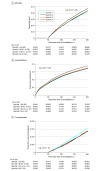Patient Care Technician Staffing and Outcomes Among US Patients Receiving In-Center Hemodialysis
- PMID: 38457178
- PMCID: PMC10924248
- DOI: 10.1001/jamanetworkopen.2024.1722
Patient Care Technician Staffing and Outcomes Among US Patients Receiving In-Center Hemodialysis
Erratum in
-
Error in Methods.JAMA Netw Open. 2024 May 1;7(5):e2419682. doi: 10.1001/jamanetworkopen.2024.19682. JAMA Netw Open. 2024. PMID: 38814649 Free PMC article. No abstract available.
Abstract
Importance: Dialysis patient care technicians (PCTs) play a critical role in US in-center hemodialysis (HD) care, but little is known about the association of PCT staffing with patient outcomes at US HD facilities.
Objective: To estimate the associations of in-center HD patient outcomes with facility-level PCT staffing.
Design, setting, and participants: This was a retrospective cohort study, with data analysis performed from March 2023 to January 2024. Data on US patients with end-stage kidney disease and their treatment facilities were obtained from the US Renal Data System. Participants included patients (aged 18-100 years) initiating in-center HD between January 1, 2016, and December 31, 2018, who continued receiving in-center HD for 90 days or more and had data on PCT staffing at their initial treating HD facility.
Exposure: Facility-level patient-to-PCT ratios (number of HD patients divided by the number of PCTs reported by the treating facility in the prior year), categorized into quartiles (highest quartile denotes the highest PCT burden).
Main outcomes and measures: Patient-level outcomes included 1-year patient mortality, hospitalization, and transplantation. Associations of outcomes with quartile of patient-to-PCT ratio were estimated using incidence rate ratios (IRRs) from mixed-effects Poisson regression, with adjustment for patient demographics and clinical and facility factors.
Results: A total of 236 126 patients (mean [SD] age, 63.1 [14.4] years; 135 952 [57.6%] male; 65 945 [27.9%] Black; 37 777 [16.0%] Hispanic; 153 637 [65.1%] White; 16 544 [7.0%] other race; 146 107 [61.9%] with diabetes) were included. After full adjustment, the highest vs lowest quartile of facility-level patient-to-PCT ratio was associated with a 7% higher rate of patient mortality (IRR, 1.07; 95% CI, 1.02-1.12), a 5% higher rate of hospitalization (IRR, 1.05; 95% CI, 1.02-1.08), an 8% lower rate of waitlisting (IRR, 0.92; 95% CI, 0.85-0.98), and a 20% lower rate of transplant (IRR, 0.80; 95% CI, 0.71-0.91). The highest vs lowest quartile of patient-to-PCT ratio was also associated with an 8% higher rate of sepsis-related hospitalization (IRR, 1.08; 95% CI, 1.03-1.14) and a 15% higher rate of vascular access-related hospitalization (IRR, 1.15; 95% CI, 1.03-1.28).
Conclusions and relevance: These findings suggest that initiation of treatment in facilities with the highest patient-to-PCT ratios may be associated with worse early mortality, hospitalization, and transplantation outcomes. These results support further investigation of the impact of US PCT staffing on patient safety and quality of US in-center HD care.
Conflict of interest statement
Figures


Similar articles
-
Dialysis Facility Staffing Ratios and Kidney Transplant Access Among Adolescents and Young Adults.JAMA. 2024 Dec 17;332(23):2003-2013. doi: 10.1001/jama.2024.18210. JAMA. 2024. PMID: 39441575 Free PMC article.
-
Patient care staffing levels and facility characteristics in U.S. hemodialysis facilities.Am J Kidney Dis. 2013 Dec;62(6):1130-40. doi: 10.1053/j.ajkd.2013.05.007. Epub 2013 Jun 28. Am J Kidney Dis. 2013. PMID: 23810689 Free PMC article.
-
Patient Care Technician Staffing in US Hemodialysis Facilities: An Ecological Study.Kidney Med. 2023 Dec 15;6(3):100782. doi: 10.1016/j.xkme.2023.100782. eCollection 2024 Mar. Kidney Med. 2023. PMID: 38419788 Free PMC article.
-
Community Racial Composition and Hospitalization Among Patients Receiving In-Center Hemodialysis.Am J Kidney Dis. 2020 Dec;76(6):754-764. doi: 10.1053/j.ajkd.2020.05.019. Epub 2020 Jul 13. Am J Kidney Dis. 2020. PMID: 32673736 Free PMC article.
-
Association of Hospitalization and Mortality Among Patients Initiating Dialysis With Hemodialysis Facility Ownership and Acquisitions.JAMA Netw Open. 2019 May 3;2(5):e193987. doi: 10.1001/jamanetworkopen.2019.3987. JAMA Netw Open. 2019. PMID: 31099872 Free PMC article.
Cited by
-
Error in Methods.JAMA Netw Open. 2024 May 1;7(5):e2419682. doi: 10.1001/jamanetworkopen.2024.19682. JAMA Netw Open. 2024. PMID: 38814649 Free PMC article. No abstract available.
-
"The Heart of the Center": Exploring the Role of the Patient Care Technician in US Dialysis Care.Kidney Med. 2024 Nov 14;7(1):100934. doi: 10.1016/j.xkme.2024.100934. eCollection 2025 Jan. Kidney Med. 2024. PMID: 39737440 Free PMC article.
References
-
- US Renal Data System . 2022 USRDS Annual Data Report: Epidemiology of Kidney Disease in the United States. National Institutes of Health, National Institute of Diabetes and Digestive and Kidney Diseases; 2022.
-
- Centers for Medicare & Medicaid Services (CMS), Department of Health and Human Services . Medicare program: end-stage renal disease quality incentive program—Final Rule. Fed Regist. 2011;76(3):627-646. - PubMed
-
- Wolfe W. The festering crisis of inadequate nephrology social work staffing: what are the options for improvement? J Nephrol Soc Work. 2014;38:10-19. doi:10.61658/jnsw.v38i1.24 - DOI
Publication types
MeSH terms
Grants and funding
LinkOut - more resources
Full Text Sources
Medical

